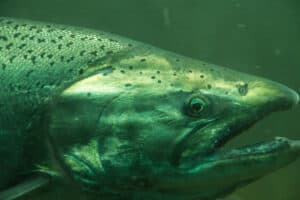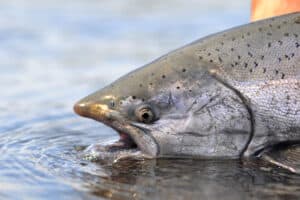When it comes to comparing steelhead vs salmon, you may be asking yourself: what’s the difference? There are fewer differences than you might expect, including their genus. For example, the steelhead’s scientific name is Oncorhynchus mykiss, and salmons are also often found in this genus. However, it is important to note that the primary difference between steelhead and salmon is the fact that the steelhead is a trout!
In this article, we will compare and contrast these two fish so that you can fully understand the ways in which they are different. You may even learn how to tell these two fish apart, though they do look strikingly similar. Let’s get started and learn more now.
Comparing Steelhead vs Salmon
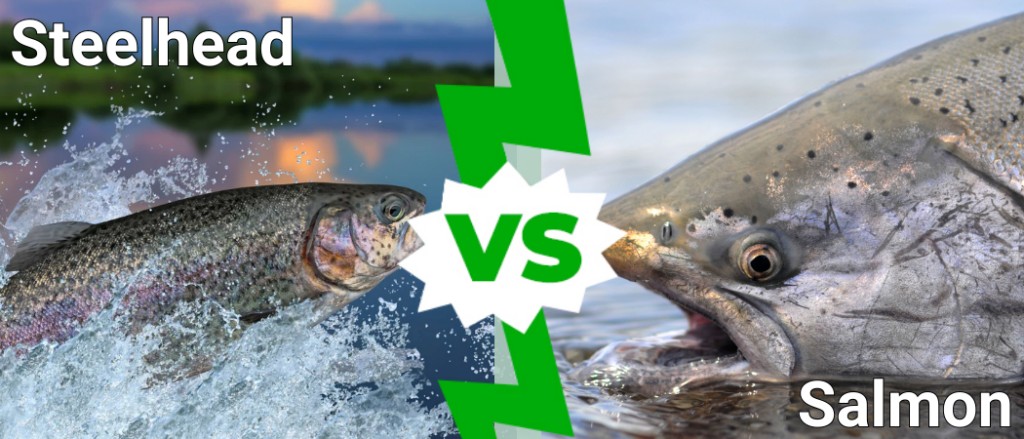
| Characteristic | Steelhead | Salmon |
|---|---|---|
| Size | 25-50 lbs on average | Varies on species; some salmon average 5 lbs but others are over 120 lbs! |
| Species | 1 specific trout species, known as Pacific trout (though often confused as a Pacific salmon species) | 8 different salmon species, known as salmon (7 Pacific salmon species, 1 Atlantic salmon species) |
| Appearance | Speckled scales, green and pink coloration, white mouths and gumline | Varies depending on the species, though some salmon have dark mouths |
| Habitat | Resides in the Pacific Ocean until spawning season | Depends on the species; some salmon live in lakes and rivers, while some live in the ocean until time to spawn |
| Spawning | Continues to live after spawning | All Pacific salmon die after spawning (Atlantic salmon live on) |
The Main Differences Between Steelhead vs Salmon
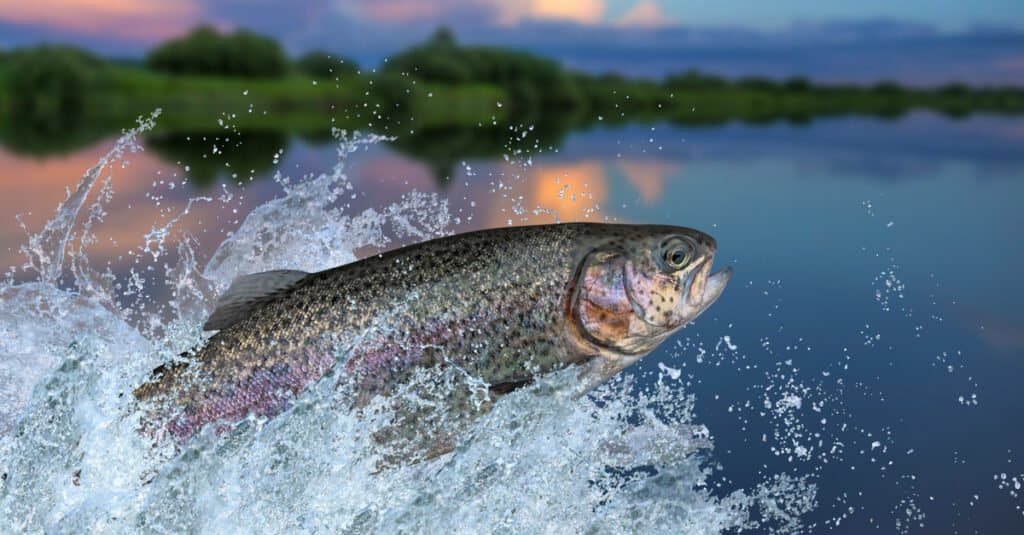
Steelhead reside exclusively in the ocean until it is time to spawn, while some salmon species reside in freshwater locations.
©FedBul/Shutterstock.com
There are only a few noticeable differences between steelhead vs salmon. Belonging to the same family and even the same genus (save the Atlantic salmon), steelhead and salmon species are extraordinarily similar. However, steelhead are considered trout, not salmon at all. This is because steelhead continue to live after spawning; Pacific salmon species do not. Some salmon also get much larger or smaller than the average steelhead, depending on the specific species of salmon. Steelhead also reside exclusively in the ocean until it is time to spawn, while some salmon species reside in freshwater locations.
Let’s discuss these differences in more detail now.
Steelhead vs Salmon: Size
You may think that size helps in the identification of a steelhead compared to a salmon. However, given that some of the largest salmon reside in the Pacific Ocean alongside steelhead, this may not be the best technique for identification!
For example, steelhead reach an average of 25-45 inches and up to 55 pounds. However, given just how many salmon species there are, the size of salmon varies greatly. Some salmon species are of a similar size to steelhead, while pink salmon average anywhere from 5-10 pounds. Chinook salmon are typically much larger than steelhead, ranging from 30-120 pounds and nearly 5 feet in length!
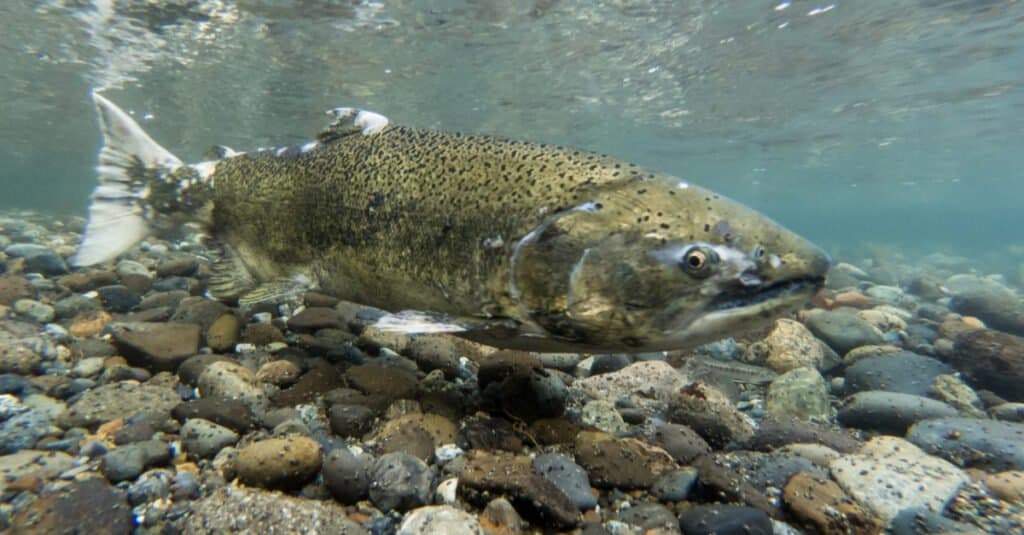
Steelhead trout have white mouths and gums, while some salmon species have a dark or black mouth and gumline.
©Kevin Cass/Shutterstock.com
Steelhead vs Salmon: Species
One key difference between steelhead and salmon can be found in their basic species classification. While both fish are from the salmon family and even the same genus (except for Atlantic salmon), steelhead trout are known as Oncorhynchus mykiss. No salmon varieties are called trout, though steelhead are occasionally listed as another type of Pacific salmon. This is of course not an accurate description and steelhead should be listed with Pacific trout instead.
Steelhead vs Salmon: Appearance
Steelhead and salmon can differ in their overall appearance depending on the salmon species. While you may not be able to tell unless you have both fish side-by-side, steelhead usually have a more streamlined body than larger salmon species such as Coho or Chinook. Many salmon species also have hooked noses, while steelhead trout rarely do.
Both fish varieties have speckles as well as many different colored markings, such as pink bellies and green tails. However, steelhead trout have white mouths and gums, while some varieties of salmon have a dark or black mouth and gumline. Keep in mind that some salmon may also have white gums, just like steelhead. Remember that individual fish vary greatly and this shouldn’t be your only method of identifying your catch!
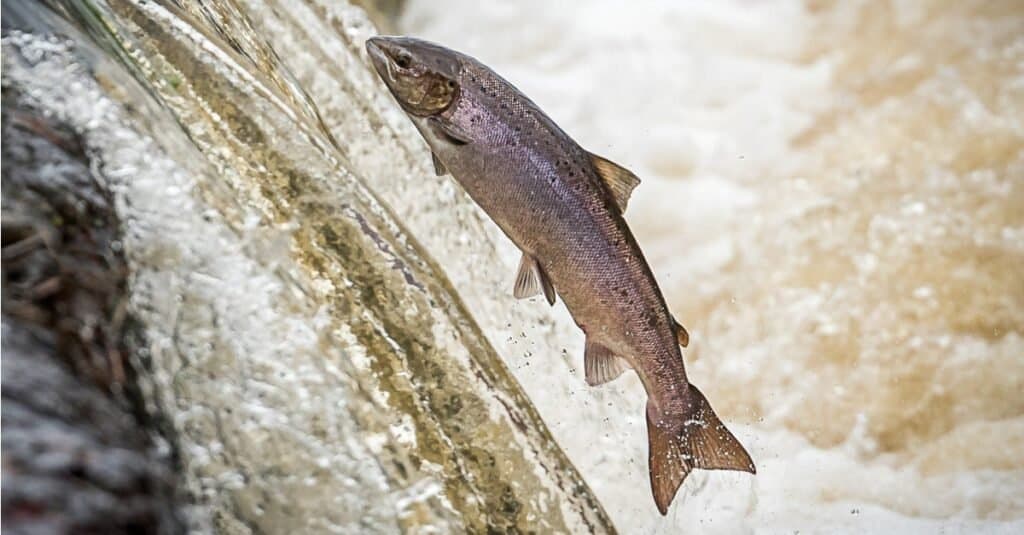
Keep in mind that some salmon may also have white gums, just like steelhead.
©iStock.com/PerfectStills
Steelhead vs Salmon: Weight
Another potential difference between steelhead vs salmon lies in their overall weight. While both of these fish can grow to be roughly the same size and can look strikingly similar, salmon species vary more in size compared to steelhead.
For example, the average steelhead trout weighs roughly 25 pounds, though it can reach up to 50 pounds. Depending on the species of salmon, they can weigh anywhere from 5-120 pounds! The smallest salmon species are far smaller than steelhead (pink salmon being among the smallest), but the largest salmon species are far larger than steelhead as well (Chinook salmon grow quite large!).
Steelhead vs Salmon: Habitat and Spawning Habits
Arguably the biggest difference between steelhead vs salmon lies in their habitats and spawning habits. We all know that salmon swim upstream in order to spawn their young before dying, and steelhead also swim upstream to spawn. However, there’s one key difference in this process.
The benefits that steelhead have over salmon lie in their ability to breed more than once. Pacific salmon species are capable of spawning upstream only once before passing on, while steelhead trout are capable of spawning multiple times in a lifetime. This means that they make their treacherous journey upstream more than once, but it also means that they breed more young than the average salmon does. Atlantic salmon are the only salmon species capable of spawning more than once, similar to steelhead.
In addition, steelhead live solely in the ocean unless they are spawning, while some salmon species reside in freshwater locations year-round. If you find a steelhead in freshwater outside of their spawning season, it’s considered a rainbow trout rather than a steelhead!
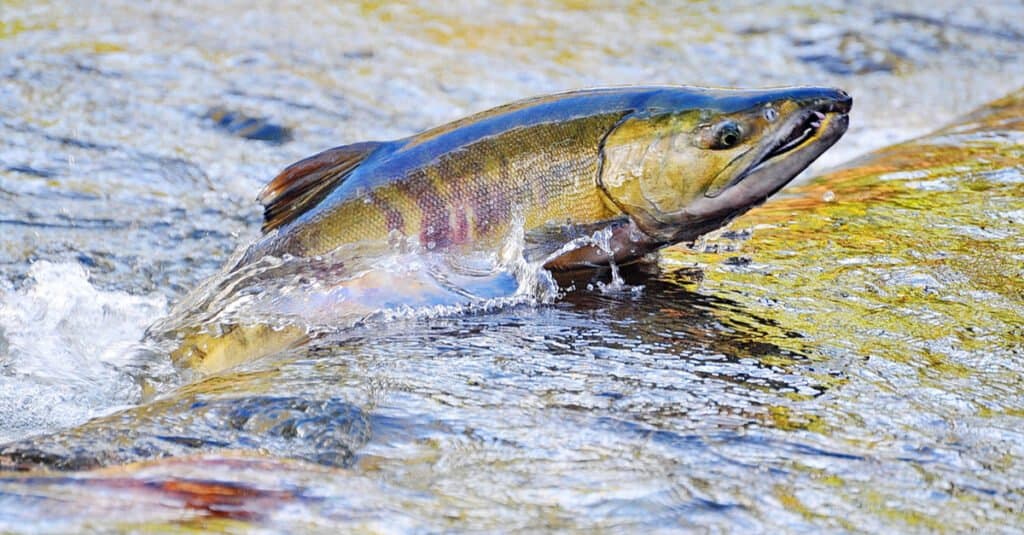
Pacific salmon species are capable of spawning upstream only once before passing on, while steelhead trout are capable of spawning multiple times in a lifetime.
©The Old Major/Shutterstock.com
Steelhead vs Salmon: Lifespan
Most salmon species live between two and seven years. Their average lifespan is four years. Steelhead trout can live up to an average of 11 years. Salmon typically spawn once and die shortly after, while steelhead trout can spawn multiple times over their lifespan.
Steelhead trout have evolved to live longer than salmon due to their migratory lifestyle. As they migrate upstream and downstream, steelhead need to be able to survive in different environments and temperatures over a long period of time. This has resulted in the development of specialized traits that allow them to live up to 8-11 years, while salmon typically only live for four years.
The differences in lifespan can also be attributed to other factors such as diet, habitat, reproductive cycle, and predation patterns. For example, steelhead is known for having a varied diet which helps them stay healthier for longer periods of time compared with salmon, which primarily feed on smaller aquatic organisms like insects or small crustaceans.
The photo featured at the top of this post is © Dec Hogan/Shutterstock.com
Thank you for reading! Have some feedback for us? Contact the AZ Animals editorial team.




